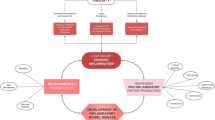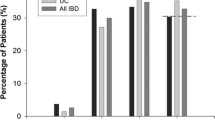Abstract
Background
Rates of obesity are increasing worldwide, as is the incidence of inflammatory bowel disease (IBD). Obesity is now considered an inflammatory state. Visceral adiposity in particular may be associated with a more severe inflammatory phenotype in IBD.
Aim
The aim of this review article is to summarise the current literature on the association between visceral adiposity and outcomes in inflammatory bowel disease
Methods
To collect relevant articles, PubMed/MEDLINE and Embase searches were performed using Boolean search phrases. Grey literature and manual searches were also performed. Abstracts were selected by two independent reviewers based on pre-determined criteria. Full text articles were reviewed, and data extracted and assessed.
Results
One hundred twenty-seven abstracts were obtained through the initial search, with 85 abstracts reviewed and 22 full text articles included. Characteristics are included in Table 1. Most of these were retrospective studies and of moderate or weak quality. Studies suggested visceral fat content is higher in Crohn’s disease than in healthy controls. Visceral adiposity was associated with an increased risk of complex Crohn’s disease phenotype (OR 26.1 95% CI 2–75.4; p = 0.02). Post-operative recurrence was higher in patients with higher visceral fat indices (RR 2.1; CI 1.5–3; p = 0.012). There were conflicting data regarding the effect of visceral adiposity on post-operative complications and the efficacy of medical therapy.
Conclusion
Visceral adiposity appears to be increased in Crohn’s disease with some evidence that it is also associated with more complex disease phenotypes. There is also a signal that post-operative recurrence rates are affected by increasing mesenteric adiposity. There is a relative lack of data in UC patients and further high-quality studies are necessary to elucidate the relationship between visceral adiposity and IBD and the implications for patient outcomes.


Similar content being viewed by others
References
Abraham C, Cho JH (2009) Inflammatory bowel disease. N Engl J Med 361(21):2066–2078
Danese S, Fiocchi C (2011) Ulcerative colitis. N Engl J Med 365(18):1713–1725
Ford AC, Moayyedi P, Hanauer SB (2013) Ulcerative colitis. Bmj 346:f432
Ng SC, Shi HY, Hamidi N, Underwood FE, Tang W, Benchimol EI et al (2017) Worldwide incidence and prevalence of inflammatory bowel disease in the 21st century: a systematic review of population-based studies. Lancet 390(10114):2769–2778
Forbes A, Escher J, Hébuterne X, Kłęk S, Krznaric Z, Schneider S et al (2017) ESPEN guideline: Clinical nutrition in inflammatory bowel disease. Clin Nutr 36(2):321–347
Hass DJ, Brensinger CM, Lewis JD, Lichtenstein GR (2006) The impact of increased body mass index on the clinical course of Crohn’s disease. Clin Gastroenterol Hepatol 4(4):482–488
Fink C, Karagiannides I, Bakirtzi K, Pothoulakis C (2012) Adipose tissue and inflammatory bowel disease pathogenesis. Inflamm Bowel Dis 18(8):1550–1557
Sheehan AL, Warren BF, Gear MW, Shepherd NA (1992) Fat-wrapping in Crohn’s disease: pathological basis and relevance to surgical practice. Br J Surg 79(9):955–958
Crohn BB, Ginzburg L, Oppenheimer GD (2000) Regional ileitis: a pathologic and clinical entity. 1932. Mt Sinai J Med 67(3):263–8
Weakley FL, Turnbull RB (1971) Recognition of regional ileitis in the operating room. Dis Colon Rectum 14(1):17–23
Association OM. Obesity Algorithm. https://obesitymedicine.org/obesity-algorithm/2020
Nic Suibhne T, Raftery TC, McMahon O, Walsh C, O’Morain C, O’Sullivan M (2013) High prevalence of overweight and obesity in adults with Crohn’s disease: associations with disease and lifestyle factors. J Crohns Colitis 7(7):e241–e248
Bryant RV, Schultz CG, Ooi S, Goess C, Costello SP, Vincent AD et al (2018) Visceral adipose tissue is associated with stricturing Crohn’s disease behavior, fecal calprotectin, and quality of life. Inflamm Bowel Dis 25(3):592–600
Ding NS, Malietzis G, Lung PFC, Penez L, Yip WM, Gabe S et al (2017) The body composition profile is associated with response to anti-TNF therapy in Crohn’s disease and may offer an alternative dosing paradigm. Aliment Pharmacol Ther 46(9):883–891
Stidham RW, Waljee AK, Day NM, Bergmans CL, Zahn KM, Higgins PDR et al (2015) Body fat composition assessment using analytic morphomics predicts infectious complications after bowel resection in Crohn’s disease. Inflamm Bowel Dis 21(6):1306–1313
Hafraoui S, Ernst O, Desreumaux P, Asselah T, Cortot A, Colombel JF (1998) Mesenteric obesity in Crohn’s disease (CD). Gastroenterology 114:A989
Ding Z, Wu XR, Remer EM, Lian L, Stocchi L, Li Y et al (2016) Association between high visceral fat area and postoperative complications in patients with Crohn’s disease following primary surgery. Colorectal Dis 18(2):163–172
Erhayiem B, Dhingsa R, Hawkey CJ, Subramanian V (2011) Ratio of visceral to subcutaneous fat area is a biomarker of complicated Crohn’s disease. Clin Gastroenterol Hepatol 9(8):684–687
Holt DQ, Moore GT, Strauss BJG, Hamilton AL, De Cruz P, Kamm MA (2017) Visceral adiposity predicts post-operative Crohn's disease recurrence. Alimentary pharmacology & therapeutics. (no pagination)
Kane H, Lynch L (2019) Innate Immune Control of Adipose Tissue Homeostasis. Trends Immunol 40(9):857–872
Sitaraman S, Liu X, Charrier L, Gu LH, Ziegler TR, Gewirtz A et al (2004) Colonic leptin: source of a novel proinflammatory cytokine involved in IBD. FASEB journal : official publication of the Federation of American Societies for Experimental Biology 18(6):696–698
Desreumaux P, Ernst O, Geboes K, Gambiez L, Berrebi D, Müller-Alouf H et al (1999) Inflammatory alterations in mesenteric adipose tissue in Crohn’s disease. Gastroenterology 117(1):73–81
Project EPHP. Quality assessment tool for qualitative studies. http://www.ephppca/tools.html. 2009.
Argeny S, Tamandl D, Scharitzer M, Stift A, Bergmann M, Riss S (2018) Visceral fat area measured with computed tomography does not predict postoperative course in Crohn s disease patients. PLoS One 13(8):e0202220
Buning C, von Kraft C, Hermsdorf M, Gentz E, Wirth EK, Valentini L et al (2015) Visceral adipose tissue in patients with crohn’s disease correlates with disease activity, inflammatory markers, and outcome. Inflamm Bowel Dis 21(11):2590–2597
Connelly TM, Juza RM, Sangster W, Sehgal R, Tappouni RF, Messaris E (2014) Volumetric fat ratio and not body mass index is predictive of ileocolectomy outcomes in Crohn’s disease patients. Dig Surg 31(3):219–224
Cravo ML, Velho S, Torres J, Costa Santos MP, Palmela C, Cruz R et al (2017) Lower skeletal muscle attenuation and high visceral fat index are associated with complicated disease in patients with Crohn’s disease: An exploratory study. Clin Nutr ESPEN 21:79–85
Feng Q, Xu XT, Zhou Y, Yan YQ, Ran ZH, Zhu J (2018) Creeping fat in patients with ileo-colonic Crohn’s disease correlates with disease activity and severity of inflammation: a preliminary study using energy spectral computed tomography. J Dig Dis 19(8):475–484
Holt DQ, Moore GT, Strauss BJ, Hamilton AL, De Cruz P, Kamm MA (2017) Visceral adiposity predicts post-operative Crohn’s disease recurrence. Aliment Pharmacol Ther 45(9):1255–1264
Bryant R, Schultz C, Ooi S, Goess C, Costello S, Vincent A et al (2018) Obesity in inflammatory bowel disease: gains in adiposity despite high prevalence of myopenia and osteopenia. Nutrients 10(9):1192
Li Y, Zhu W, Gong J, Zhang W, Gu L, Guo Z et al (2015) Visceral fat area is associated with a high risk for early postoperative recurrence in Crohn’s disease. Colorectal Dis 17(3):225–234
Liu G, Wu X, Li Y, Rui Y, Stocchi L, Remzi FH et al (2016) Postoperative excessive gain in visceral adipose tissue as well as body mass index are associated with adverse outcomes of an ileal pouch. Gastroenterology report 5(1):29–35
Magro DO, Barreto MRL, Cazzo E, Camargo MG, Kotze PG, Coy CSR (2018) Visceral fat is increased in individuals with Crohn’s disease: a comparative analysis with healthy controls. Arq Gastroenterol 55(2):142–147
Parmentier-Decrucq E, Duhamel A, Ernst O, Fermont C, Louvet A, Vernier-Massouille G et al (2009) Effects of infliximab therapy on abdominal fat and metabolic profile in patients with Crohn’s disease. Inflamm Bowel Dis 15(10):1476–1484
Shen W, Cao L, Li Y, Cai X, Ge Y, Zhu W (2018) Visceral fat is associated with mucosal healing of infliximab treatment in Crohn’s disease. Dis Colon Rectum 61(6):706–712
Thiberge C, Charpentier C, Gillibert A, Modzelewski R, Dacher JN, Savoye G et al (2018) Lower subcutaneous or visceral adiposity assessed by abdominal computed tomography could predict adverse outcome in patients with Crohn’s disease. J Crohns Colitis 12(12):1429–1437
Van Der Sloot KW, Joshi AD, Bellavance DR, Gilpin KK, Stewart KO, Lochhead P et al (2017) Visceral adiposity, genetic susceptibility, and risk of complications among individuals with Crohn’s disease. Inflamm Bowel Dis 23(1):82–88
Wei Y, Zhu F, Gong J, Yang J, Zhang T, Gu L et al (2018) High visceral to subcutaneous fat ratio is associated with increased postoperative inflammatory response after colorectal resection in inflammatory bowel disease. Gastroenterology research and practice 2018:6270514
Yadav DP, Kedia S, Madhusudhan KS, Bopanna S, Goyal S, Jain S et al (2017) Body composition in Crohn’s disease and ulcerative colitis: correlation with disease severity and duration. Can J Gastroenterol Hepatoly. 2017
Eder P, Adler M, Dobrowolska A, Kamhieh-Milz J, Witowski J (2019) The role of adipose tissue in the pathogenesis and therapeutic outcomes of inflammatory bowel disease. Cells 8(6):628
Zulian A, Cancello R, Micheletto G, Gentilini D, Gilardini L, Danelli P et al (2012) Visceral adipocytes: old actors in obesity and new protagonists in Crohn’s disease? Gut 61(1):86–94
Coope A, Pascoal LB, da Silva FAR, Botezelli JD, Ayrizono MdLS, Milanski M et al (2017) Transcriptional and molecular pathways activated in mesenteric adipose tissue and intestinal mucosa of Crohn's disease patients. Int J Inflam. 2017:7646859
Rivera ED, Coffey JC, Walsh D, Ehrenpreis ED (2019) The mesentery, systemic inflammation, and Crohn’s disease. Inflamm Bowel Dis 25(2):226–234
Coffey CJ, Kiernan MG, Sahebally SM, Jarrar A, Burke JP, Kiely PA et al (2018) Inclusion of the mesentery in ileocolic resection for crohn’s disease is associated with reduced surgical recurrence. J Crohns Colitis 12(10):1139–1150
Coffey JC, O‘Leary DP, Kiernan MG, Faul P (2016) The mesentery in Crohn's disease: friend or foe? Current opinion in gastroenterology 32(4):267–73
Colombo F, Rizzi A, Ferrari C, Frontali A, Casiraghi S, Corsi F et al (2015) Bariatric surgery in patients with inflammatory bowel disease: an accessible path? Report of a case series and review of the literature. J Crohns Colitis 9(2):185–190
Braga Neto MB, Gregory MH, Ramos GP, Bazerbachi F, Bruining DH, Abu Dayyeh BK et al (2020) Impact of bariatric surgery on the long-term disease course of inflammatory bowel disease. Inflamm Bowel Dis 26(7):1089–1097
Magouliotis DE, Tasiopoulou VS, Sioka E, Chatedaki C, Zacharoulis D (2017) Impact of bariatric surgery on metabolic and gut microbiota profile: a systematic review and meta-analysis. Obes Surg 27(5):1345–1357
Acknowledgements
This study is a collaborative effort, and the authors would like to acknowledge all those who contributed. Specifically, Catherine Rowan and Aoibhlinn O’Toole were involved in the conception of the study. Catherine Rowan and John McManus carried out the literature search and review. Catherine Rowan and Aoibhlinn O’Toole drafted the report. John McManus and Karen Boland assisted in editing the final draft of the manuscript.
Author information
Authors and Affiliations
Corresponding author
Additional information
Publisher's Note
Springer Nature remains neutral with regard to jurisdictional claims in published maps and institutional affiliations.
Rights and permissions
About this article
Cite this article
Rowan, C.R., McManus, J., Boland, K. et al. Visceral adiposity and inflammatory bowel disease. Int J Colorectal Dis 36, 2305–2319 (2021). https://doi.org/10.1007/s00384-021-03968-w
Accepted:
Published:
Issue Date:
DOI: https://doi.org/10.1007/s00384-021-03968-w




